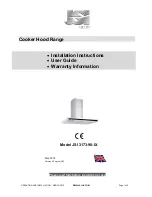
- 18 -
treated as domestic waste, but should be delivered to a
suitable electric and electronic appliance recycling
collection point. Follow local guidelines when disposing
of waste. For more information on the treatment, re-use
and recycling of this product, please contact your local
authority, domestic waste collection service or the shop
where the appliance was purchased.
INSTALLATION INSTRUCTIONS
Assembly and electrical connections must be carried
out by specialised personnel.
• Electric Connection
The appliance has been manufactured as a class II,
therefore no earth cable is necessary.
The connection to the mains is carried out as follows:
BROWN =
L
line
BLUE =
N
neutral
If not provided, connect a plug for the electrical load
indicated on the description label. Where a plug is
provided, the cooker hood must be installed in order that
the plug is easily accessible.
An omnipolar switch with a minimum aperture of 3mm
between contacts, in line with the electrical load and local
standards, must be placed between the appliance and
the network in the case of direct connection to the
electrical network.
•
The minimum distance between the support surfaces
of the cooking pots on the cooker top and the lowest
part of the cooker hood must be at least 65 cm.
If a connection tube composed of two parts is used, the
upper part must be placed outside the lower part.
Do not connect the cooker hood exhaust to the same
conductor used to circulate hot air or for evacuating fumes
from other appliances generated by other than an
electrical source.
Before proceeding with the assembly operations, remove
the anti-grease filter(s) (Fig.5) so that the unit is easier
to handle.
In the case of assembly of the appliance in the suction
version prepare the hole for evacuation of the air.
•
We recommend the use of an air exhaust tube which
has the same diameter as the air exhaust outlet hole. If
a pipe with a smaller diameter is used, the efficiency of
the product may be reduced and its operation may
become noisier.
•
Warning! Plastic spacer fitting.
This product may also be supplied with a plastic spacer
O
,
which should be fitted before the hood is installed (Fig. 2a).
Fix the spacer to the hood using screws
P
(Fig. 2a).
To assemble the unit correctly, align the front panel of the
hood with the wall cabinet and decide on the distance
necessary to fill in any space remaining between the hood
and the wall.
Once the distance has been established, use a cutter to
remove the excess plastic (Fig. 2a).
•
INSTALLATION
The following instruction should be followed to carry out
the correct installation of the cooker hood.
1)
Mounting of the cooker hood on the lower side of
the cupboard.
2)
Selection of the version (extraction or filtration)
GENERAL
Carefully read the following impor tant information
regarding installation safety and maintenance. Keep this
information booklet accessible for further consultations.
The appliance has been designed for use in the ducting
version (air exhaust to the outside), filtering version (air
circulation on the inside ) or with external motor .
SAFETY PRECAUTION
1.
Take care when the cooker hood is operating
simultaneously with an open fireplace or burner that
depend on the air in the environment and are supplied
by other than electrical energy, as the cooker hood
removes the air from the environment which a burner or
fireplace need for combustion. The negative pressure in
the environment must not exceed 4Pa (4x10
-5
bar).
Provide adequate ventilation in the environment for a
safe operation of the cooker hood.
Follow the local laws applicable for exter nal air
evacuation.
Before connecting the model to the electricity net-
work:
- control the data plate (positioned inside the appliance)
to ascertain that the voltage and power correspond to
the network and the socket is suitable. If in doubt ask a
qualified electrician.
- If the power supply cable is damaged, it must be
replaced with another cable or a special assembly, which
may be obtained direct from the manufacturer or from
the Technical Assistance Centre.
2. WARNING !
In certain circumstances electrical appliances may
be a danger hazard.
A) Do not check the status of the filters while the
cooker hood is operating
B) Do not touch bulbs or adjacent areas, during or
straight after pr olonged use of the lighting
installation.
C) Flambè cooking is prohibited underneath the
cooker hood
D) Avoid free flame, as it is damaging for the filters
and a fire hazard
E) Constantly check food frying to avoid that the
overheated oil may become a fire hazard
F) Disconnect the electrical plug prior to any
maintenance.
G) This appliance is not intended for use by young
children or infirm persons without supervision
H) Young children should be supervised to ensure
they do not play with the appliance
I) There shall be adequate ventilation of the room
when the rangehood is used at the same time as
appliances burning gas or other fuels
L) There is a risk of fire if cleaning is not carried out
in accordance with the instructions
This appliance conforms to the European Directive EC/
2002/96, Waste Electrical and Electronic Equipment
(WEEE). By making sure that this appliance is disposed
of in a suitable manner, the user is helping to prevent
potential damage to the environment or to public health.
The
symbol on the product or on the accompanying
paperwork indicates that the appliance should not be
ENGLISH
GB


























